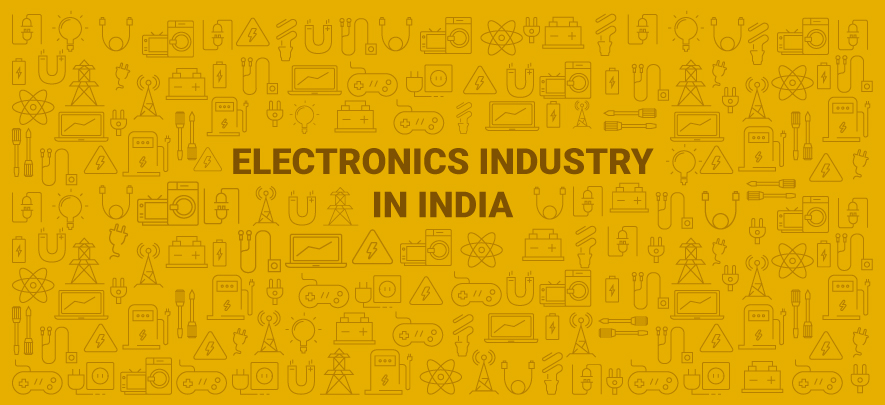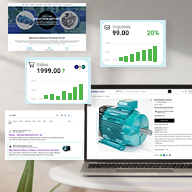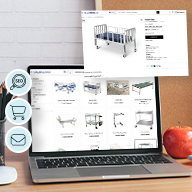Indian Electronics Industry: Drivers and trends

Business Development
271 week ago — 9 min read
The Indian electronics sector is one of the fastest-growing industries in India in terms of production and exports driven by macro factors such as growing middle-class population and increased disposable income. Declining production prices of these electronic devices which are passed on to the consumer and adoption of high-end technology leading to the need to buy newer products, have helped consumption.
This industry in India is expected to become the fifth largest in the world by 2025 with a growth rate of 17% CAGR as per Invest India. In 2016-17 a significant milestone was achieved in this sector when India’s domestic electronics production exceeded imports of electronic goods. And this has happened due to various industry and government led growth drivers.
Growth drivers of the electronics industry
Increased domestic demand and new markets
Rising demand from rural markets especially for washing machines and mobile phones and the changing household type to nuclear families coupled with the changing lifestyles of consumers has increased domestic demand of electronics.
In 2016-17 a significant milestone was achieved in this sector when India’s domestic electronics production exceeded imports of electronic goods.
Discretionary income and easy credit options
Significant increase in discretionary income with consumers wanting to spend more and save less and availability of multiple financing schemes have helped change the mindset of consumers that now look at electronic items like ACs, washing machines and big TVS form luxury item to items of necessity. Also exchange offers, easier access to credit and adoption of credit cards have made it easier for not only consumers to buy more but also replace more often than before.
Technology adoption
Consumers are becoming technology aware and want to stay abreast with the latest and newest. They are demanding products with built in artificial intelligence which make their life easier. Washing machines with load sensor which decide the appropriate cycle is one such example.
An attractive industry for investment
The Indian consumer electronics sector has attracted several strong investments in the form of mergers and acquisitions by key participants of the global market and other FDI (foreign direct investment) inflows. 100% FDI is now in electronic hardware manufacturing, FDI into single brand retail has been increased from 51% to 100% with plans to hike multi brand retail to 51%.
Broadband penetration
Increased broadband penetration in the country will open up further avenues of growth for the electronics industry. Given the high demand for broadband and communication equipment, including mobile handsets and their accessories, this segment is also likely to drive the demand for electronic components and products.
Support for manufacturing
India is likely to emerge as a potential future manufacturing hub for the region. Specific factors that are likely to boost manufacturing in India include reduction in borrowing costs, export incentives, reduction of customs duties on raw materials and components, and improvement in the ease of doing business.
Emerging trends for electronics industry
The Indian electronics industry is in the midst of an exciting phase owing to new technology, introduction of innovative products and global competition which keeps the industry on its toes. This means that manufacturers must focus on continuous innovation and improvement of products. Here are some notable trends of the industry:
Technology-conscious consumers
Consumers are abreast with new technology and are now demanding products with built-in artificial intelligence. This has led to the development of intelligent electronics and consumer durable products. For instance, washing machines can now sense the load and decide the appropriate washing cycle. Artificial intelligence will move beyond consumer products and will be available in several medical electronics and industrial electronic products.
Big players expanding into newer segments
Big players are expanding their current offering to get a bigger piece of the pie. Panasonic is looking beyond consumer electronics to business solutions and Xiaomi into the white goods sector. The Hero group’s Hero Electronics is said to enter the consumer good industry and launch AI products while LivPure has entered the air-conditioners space by launching on Flipkart.
Shared economy
The industry is not only looking at selling appliances but also renting it out offered add on services like relocation and free maintenance to make it more attractive than owning them. This is targeted to consumers who are in need of appliances for a short terms or do not want the hassles like servicing, repairs, etc
Contract manufacturing
Many consumer electronics appliance companies have started outsourcing manufacturing to local contract manufacturers like Dixon and Amber. While this was more often done in China rising power costs, high labour costs (almost 3 times of India) and a stronger yuan have made India an attractive proposition. In early 2019, Samsung was in talks with Dixon and Foxconn to make TVs in India.
Trends in the electronic components industry
The Indian electronics industry is in the midst of an exciting phase owing to new technology, introduction of innovative products and global competition which keeps the industry on its toes. This means that manufacturers must focus on continuous innovation and improvement of products. Here are some notable trends of the industry:
Miniaturisation and the addition of multiple functions
The trend of miniaturisation has led to the creation of smaller devices or components. Consumer demand for smaller products to make them more handy and easy to manage has resulted in miniaturised products with greater density of components, made possible through VLSI designs. This often leads to lower cost of production, resulting in fall of product prices. This trend is expected to continue and will impact the traditional component market, as most traditional components will be replaced by chip components and integrated circuits.
Consumer demand for smart and connected devices
Smart devices require at least a microcontroller to add intelligence to the device, one or more sensors to allow for data collection, one or more chips for connectivity and data transmission, and a memory component. The connected devices that transmit information across the relevant networks will rely on innovations from semiconductor players—highly integrated microchip designs, for instance, and very low power functions in certain applications.
Large data driving development
Integrated circuits and modules for high frequencies will be in vogue taking into the large data that needs to be transmitted in a very short time in communication, sensors or astronautics. Advances in integrated circuit technology are driving packaging and interconnect designers to accommodate more input/output connections and larger sized dies, which dissipate more power and operate at faster speeds. This will also generate a demand for components and products suitable for high frequency applications.
Emerging System on Chip (SoC) based devices
System on Chip (SoC) based devices with provision for optimal power and connectivity features as well as with sensor integration, will be in demand to make products smarter to support the wide adoption of ÍoT. The first generation of such chips are already on the way, although it will probably be a few generations before chips can deliver all the functionality required.
New sensors based on micro electromechanical systems (MEMS) technology for IoT
Such new sensors will be developed for IoT products and will have applications beyond motion and image sensing. These include products that measure humidity, altitude, food calorie composition, and human health indicators.
Electric vehicles and connected mobility related applications
EVs and mobility related appliances have already opened up huge opportunities for power electronics devices and components, including power management semiconductors, etc. However, the desire for a longer driving range between charges, faster battery charging times, increasing electronics integration for infotainment, safety and security, and other applications will further technological advances, increasing the total electronics content of EVs.
Posted by
GlobalLinker StaffWe are a team of experienced industry professionals committed to sharing our knowledge and skills with small & medium enterprises.
Network with SMEs mentioned in this article
View GlobalLinker 's profile
Most read this week














Comments (1)
Please login or Register to join the discussion